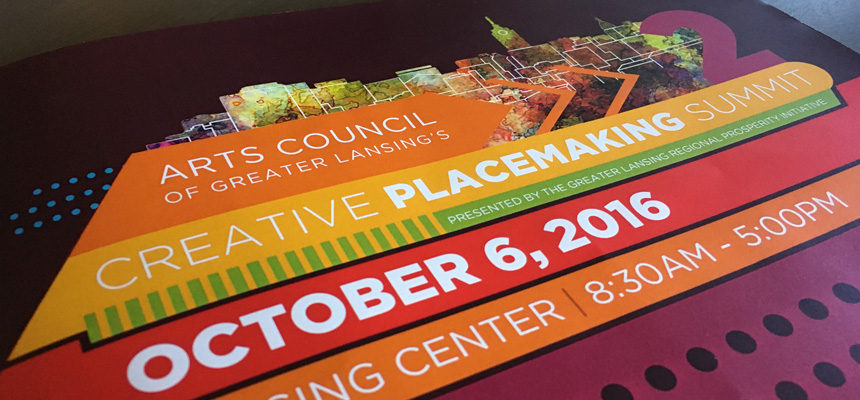When we received the program for the Arts Council of Great Lansing’s Creative Placemaking Summit, we were very excited to see a local conference agenda that clearly valued the principles that landscape architects espouse! How did they know??
And then we wondered, who else would consider this topic to be valuable?
We decided that it didn’t matter. This conference was right up our alley and right in our backyard – placemaking in Lansing, MI.

When we arrived I was surprised to see people from a variety of backgrounds and business interests; there were developers, city officials and other design professionals – that made sense. But then there were other disciplines like artists (including musicians, dancers, painters, etc.), realtors, counselors, and even a refugee development center. How is it that all of these people in the greater Lansing area find placemaking to be a concept that impacts them either professionally or personally?
The answer came fairly early in the conference with the keynote speaker Dr. Katherine Loflin defining placemaking and offering research-based findings on why placemaking matters in a community.
From 2008-2010 Dr. Loflin conducted a study for Gallup and the Knight Foundation to answer the question: What makes people love their communities?
She studied 43,000 people over the three-year period in 26 diverse communities. At the end of the study, she learned that there were three main things that contributed to people’s place attachment (the things that make you love a place and want to live there).
Social Offerings was the number one condition affecting place attachment. There are formal social offerings like events (e.g. MSU football game, Arts Night Out). And then there are informal social offerings such as civility, interconnectedness and caring for one another within a community (e.g. running into an acquaintance at the post office and having a meaningful conversation).
Aesthetics was the second most important condition affecting place attachment and is the factor that most closely relates to our skills as landscape architects. Aesthetics are the natural green spaces and the developed spaces within a community. Aesthetics includes the good and the bad. Dr. Loflin found that people who drive past blight on their way to work have less place attachment than their counterparts who don’t see blight regularly. Poor aesthetics in a community will counterbalance the positive aesthetics.
Openness was third most important condition affecting place attachment. Historically, openness only referred to disadvantaged groups (LGBT, African Americans, poor, etc.). However for placemaking, it is important to consider all groups that make up your community additionally including millennials and young singles, young marrieds with/without children, families, retired people, and the list goes on. One example of community openness that Dr. Loflin shared was a neighborhood where front porches contained chairs and people; a welcoming place where neighbors can gather without the commitment of staying.
Now that I had a clearer framework for successful placemaking, I was intrigued to hear other attendees discuss our community with its virtues and its foibles. One thing that I heard on multiple occasions was that Lansing is improving, but it still needs better “visuals” or “aesthetics”. I couldn’t agree more!
It is encouraging to know that other people in the community see what I see; a strong community of people who love their city. And yet it is a city that is still growing into itself. Suban Cooley illustrates this tension well in her recent spoken word “Our Lansing”, which captures the culture and resiliency of our capitol city. Suban asks, “Do you see yourself now Lansing? Do you?”
We live and work (and play) in a community that is made up of creative thinkers and committed problem solvers; people who are concerned about making Lansing a great place! This is exciting and we are honored to be part of the placemaking that is happening in the greater Lansing area!

Leave a Reply